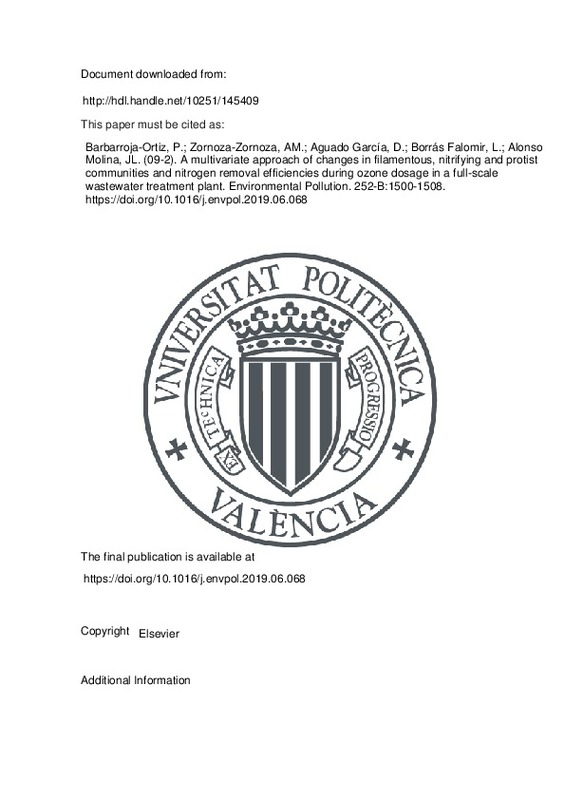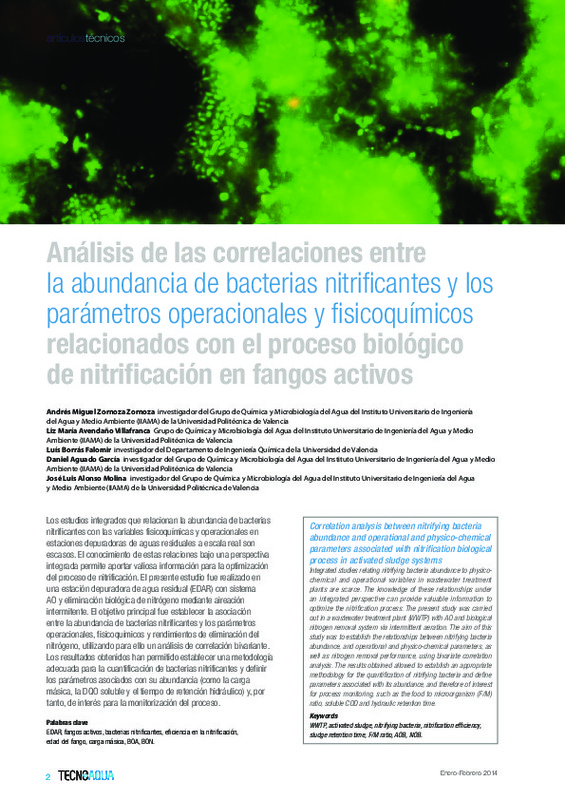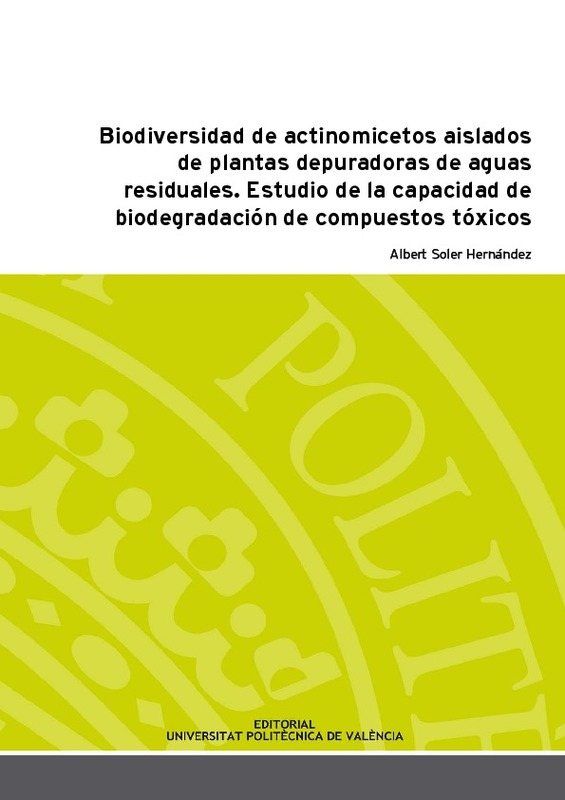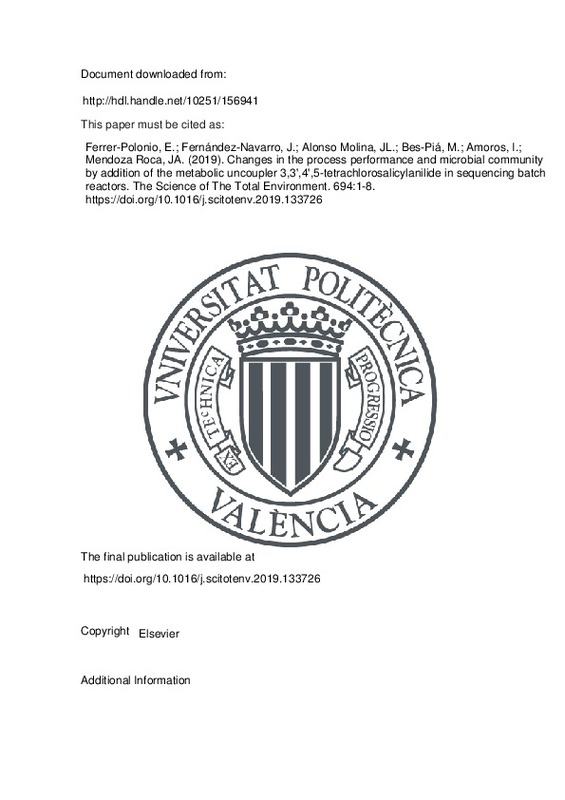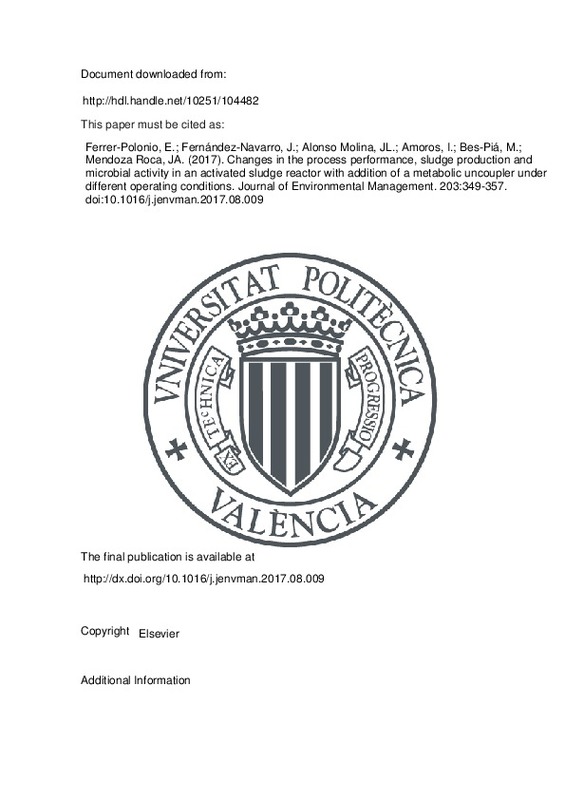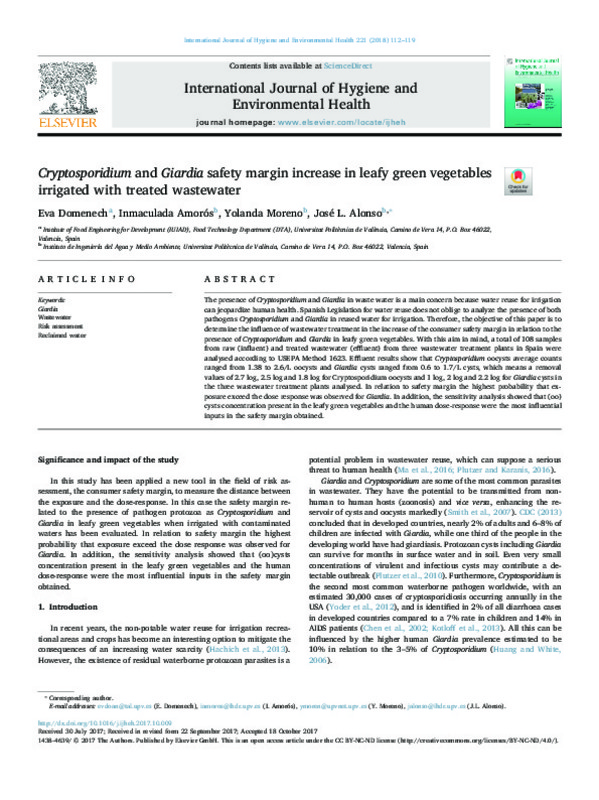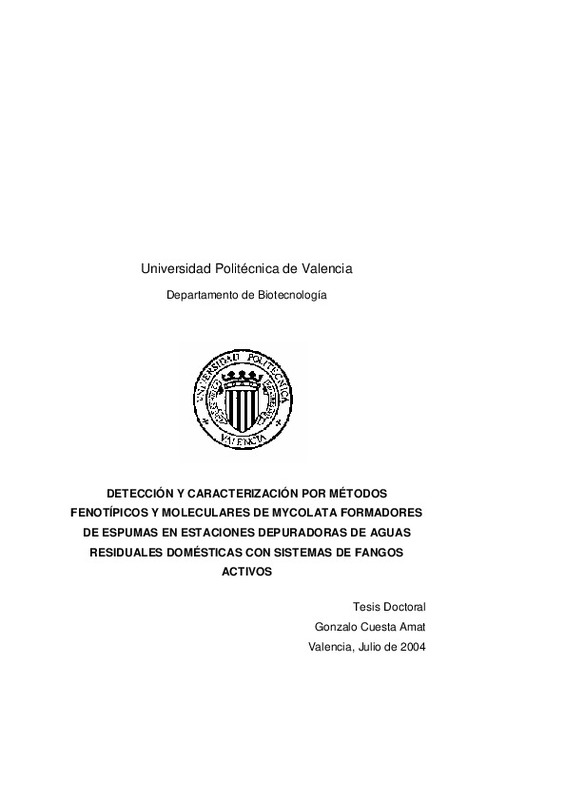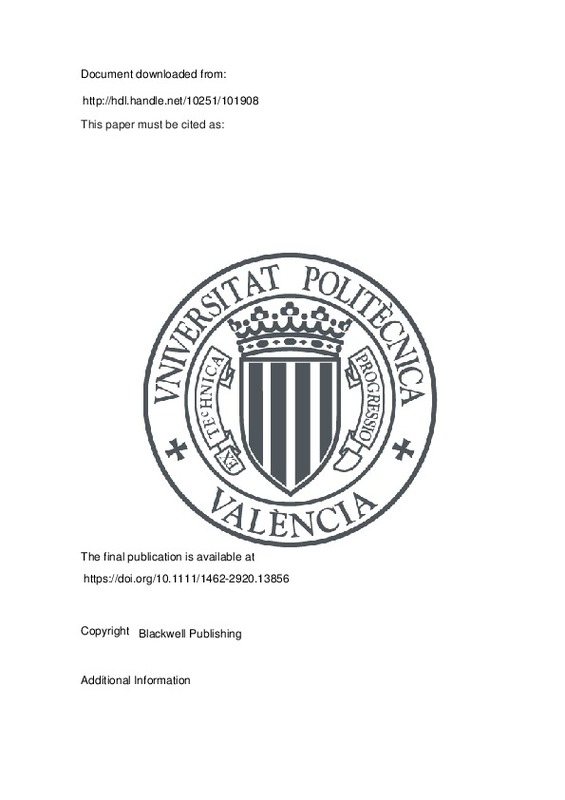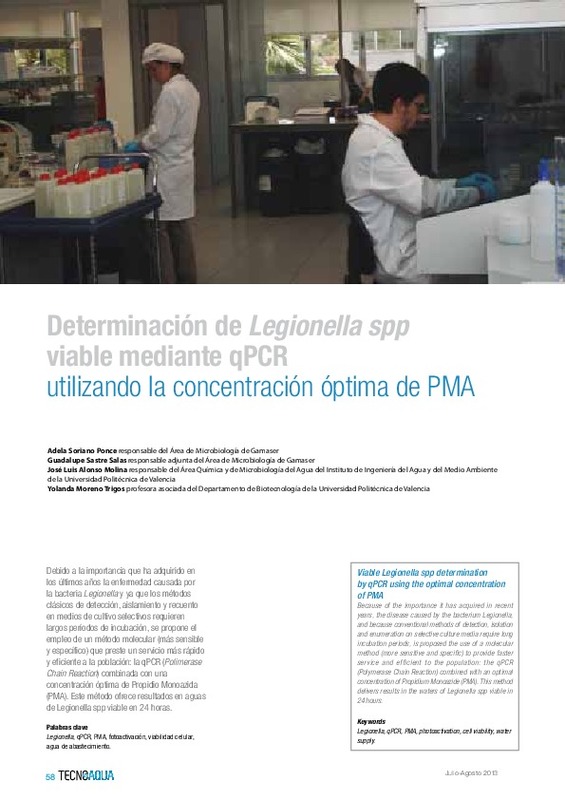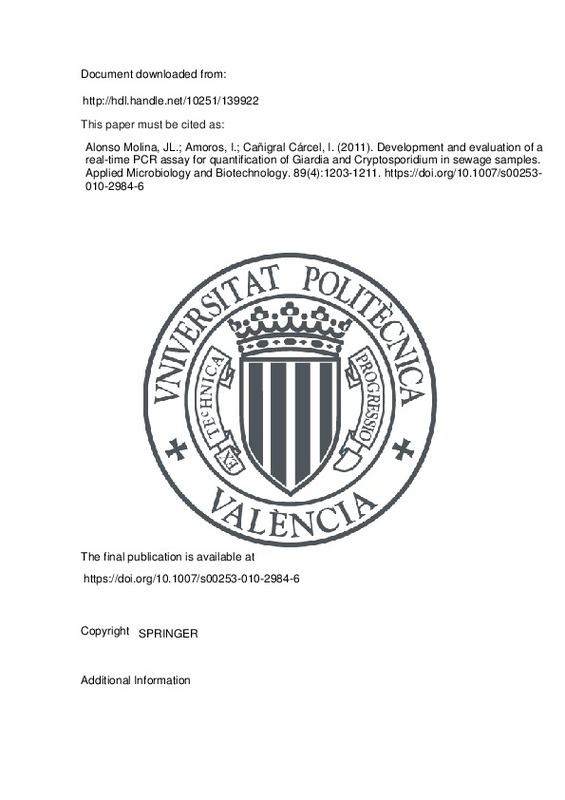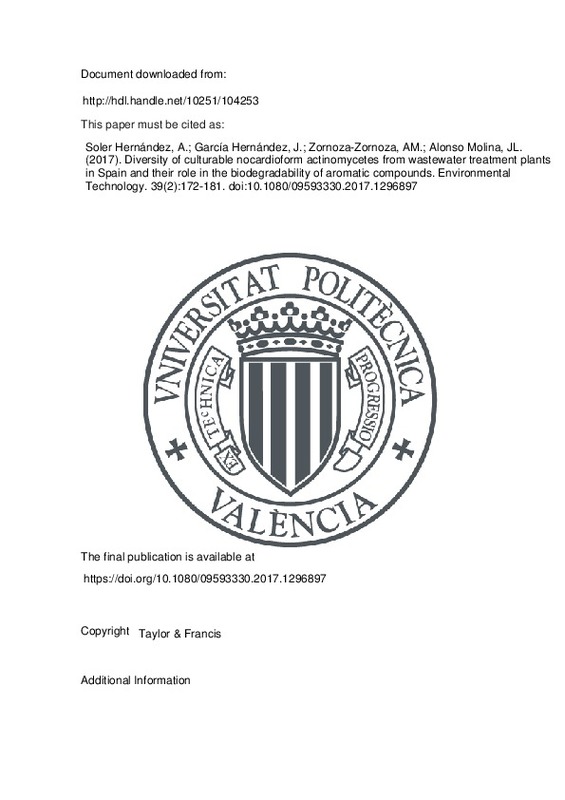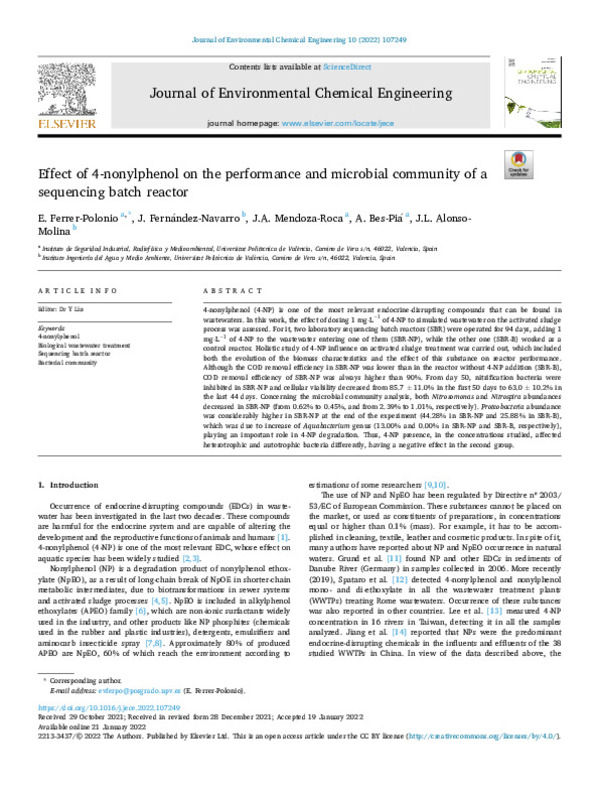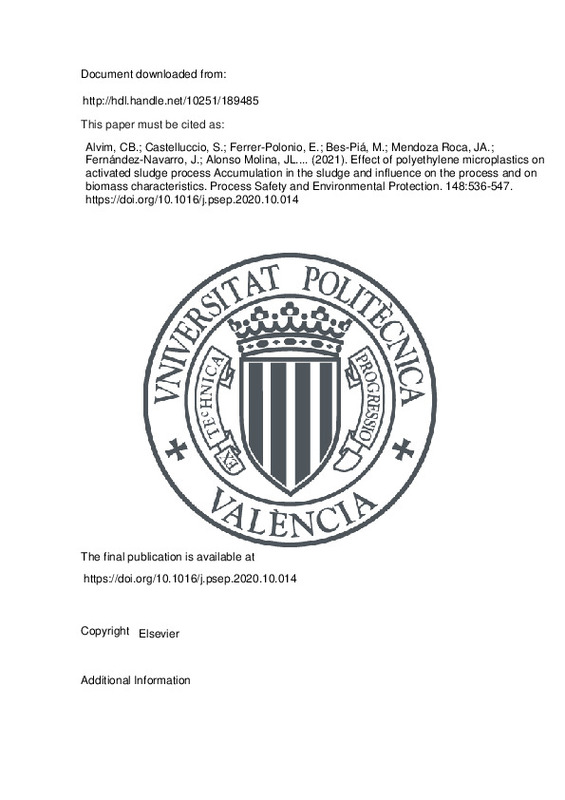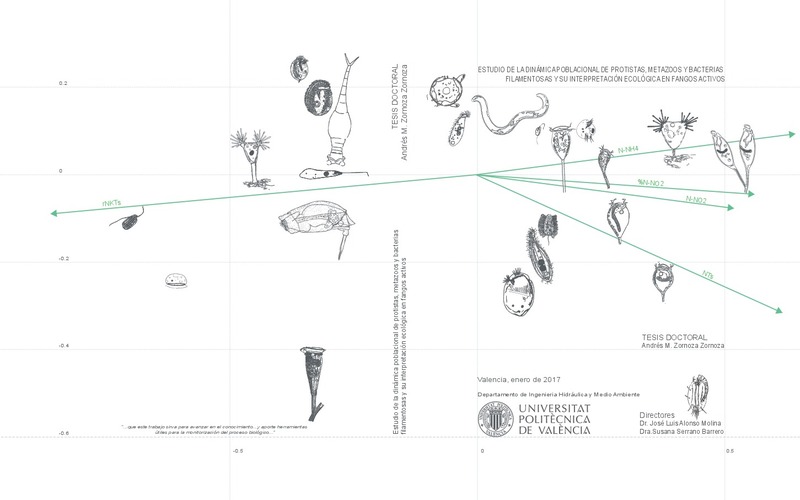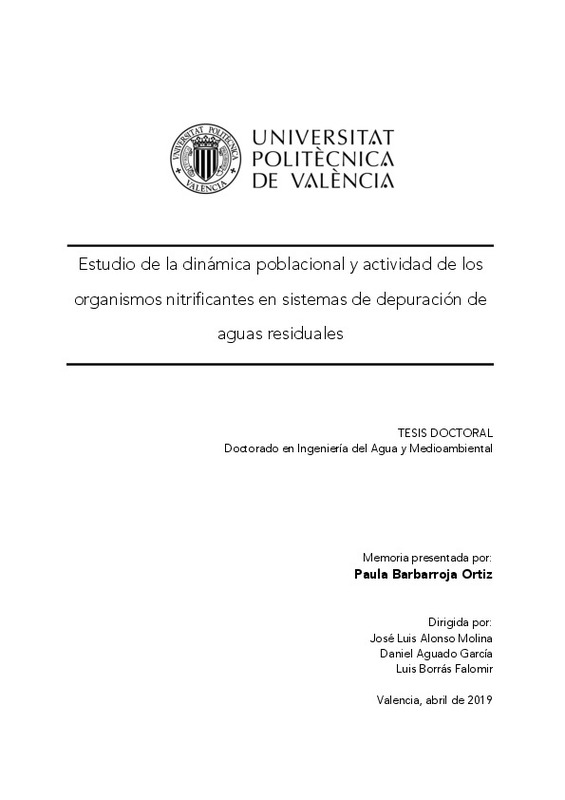

Listar por autor "Alonso Molina, José Luís"
RiuNet: Repositorio Institucional de la Universidad Politécnica de Valencia
- RiuNet repositorio UPV
- :
- Listar por autor
JavaScript is disabled for your browser. Some features of this site may not work without it.
Buscar en RiuNet
Listar
Mi cuenta
Ayuda RiuNet
Admin. UPV
Listar por autor "Alonso Molina, José Luís"
Mostrando ítems 1-20 de 53
-
Barbarroja-Ortiz, Paula; Zornoza-Zornoza, Andrés Miguel; Aguado García, Daniel; Borrás Falomir, Luis; Alonso Molina, José Luís (Elsevier, 2019-09)[EN] The application of low ozone dosage to minimize the problems caused by filamentous foaming was evaluated in two bioreactors of an urban wastewater treatment plant. Filamentous and nitrifying bacteria, as well as protist ...
-
Alonso-Vázquez, Pablo; Lujan Facundo, Maria Jose; Cuartas Uribe, Beatriz Elena; Bes-Piá, M.A.; Alonso Molina, José Luís; Mendoza Roca, José Antonio (Elsevier, 2023-11)[EN] Recently, the increasing amount of plastic waste has raised concerns about microplastics in aquatic environments. In this study, microplastics between 0.1 and 5 mm in samples from different points of three Drinking ...
-
Zornoza-Zornoza, Andrés Miguel; Avendaño-Villafranca, Liz Maria; Borrás Falomir, Luis; Aguado García, Daniel; Alonso Molina, José Luís (Infoedita, 2014)[ES] Los estudios integrados que relacionan la abundancia de bacterias nitrificantes con las variables fisicoquímicas y operacionales en estaciones depuradoras de aguas residuales a escala real son escasos. El conocimiento ...
-
Soler Hernández, Albert (Editorial Universitat Politècnica de València, 2012-03-09)Actualmente, en el tratamiento de aguas residuales no se presta demasiada atención a los microorganismos que realizan la depuración ni interfieren en el proceso. Es por ello que con este estudio se pretende estudiar este ...
-
Ferrer-Polonio, Eva; Mendoza Roca, José Antonio; Iborra Clar, Alicia; Alonso Molina, José Luís; Pastor Alcañiz, Laura (Elsevier, 2016-11)Biological treatment of hypersaline wastewaters such as fermentation brine from table olive processing (FTOP), was carried out using four sequential biological reactors (SBRs). These wastewaters were characterized by ...
-
Ferrer-Polonio, Eva; Fernández-Navarro, Julián; Alonso Molina, José Luís; Bes-Piá, M.A.; Amoros, Inmaculada; Mendoza Roca, José Antonio (Elsevier, 2019-12-01)[EN] A complete study about the effects of 3,3',4',5-tetrachlorosalicylanilide (TCS) on organic matter elimination performance, sludge production and on the microbial community of a biological wastewater treatment process ...
-
Ferrer-Polonio, Eva; Fernández-Navarro, Julián; Alonso Molina, José Luís; Amoros, Inmaculada; Bes-Piá, M.A.; Mendoza Roca, José Antonio (Elsevier, 2017)[EN] Sludge production in wastewater treatment plants is nowadays a big concern due to the high produced amounts and their characteristics. Consequently, the study of techniques that reduce the sludge generation in wastewater ...
-
Zuriaga Agustí, Elena; Mendoza Roca, José Antonio; Bes Piá, Mª Amparo; Alonso Molina, José Luís; Fernández-Giménez, E.; Alvarez-Requena, C.; Munagorri-Manueco, F.; Ortiz-Villalobos, G. (IWA Publishing, 2016-09-01)In the last years, biological treatment plants for the previously separated organic fraction from municipal solid wastes (OFMSW) have gained importance. In these processes a liquid effluent (liquid fraction from the digestate ...
-
Ferrer-Polonio, Eva; Mendoza Roca, José Antonio; Iborra Clar, Alicia; Alonso Molina, José Luís; Pastor Alcañiz, Laura (Elsevier, 2015-08-01)Biological treatment of hypersaline effluents with high organic matter concentrations is difficult to carry out and it can require a long start-up phase. This is the case of the treatment of fermentation brines from the ...
-
Doménech Antich, Eva Mª; Amoros, Inmaculada; Moreno Trigos, Mª Yolanda; Alonso Molina, José Luís (Elsevier, 2018)[EN] The presence of Cryptosporidium and Giardia in waste water is a main concern because water reuse for irrigation can jeopardize human health. Spanish Legislation for water reuse does not oblige to analyze the presence ...
-
Cuesta Amat, Gonzalo (Universitat Politècnica de València, 2008-07-24)Los actinomicetos nocardioformes que contienene ácidos micólicos (mycolata) pertenecen al suborden Corynebacterinea, orden Actinomycetales. Este grupo de microorganismos contiene especies filamentosas que causan problemas ...
-
Moreno-Mesonero, Laura; Moreno Trigos, Mª Yolanda; Alonso Molina, José Luís; Ferrús Pérez, Mª Antonia (Blackwell Publishing, 2017)[EN] Helicobacter pylori is one of the most concerning emerging waterborne pathogens. It has been suggested that it could survive in water inside free-living amoebae (FLA), but nobody has studied this relationship in the ...
-
Soriano Ponce, Adela; Sastre Salas, Guadalupe; Alonso Molina, José Luís; Moreno Trigos, Mª Yolanda (Infoedita, 2013)[EN] Because of the importance it has acquired in recent years, the disease caused by the bacterium Legionella, and because conventional methods of detection, isolation and enumeration on selective culture media require ...
-
Alonso Molina, José Luís; Amoros, Inmaculada; Cañigral Cárcel, Irene (SPRINGER, 2011)[EN] Cryptosporidium and Giardia are major causes of diarrheal disease in humans worldwide and are major causes of protozoan waterborne diseases. Two DNA TaqMan PCR-based Giardia and Cryptosporidium methods targeting a ...
-
Soler Hernández, Albert; García Hernández, Jorge; Zornoza-Zornoza, Andrés Miguel; Alonso Molina, José Luís (Taylor & Francis, 2017)[EN] Currently, municipal and industrial wastewater treatment plants (WWTPs) are mainly focusing on reduction of biological oxygen demand and on the removal of nutrients. However, there are microorganisms that interfere ...
-
Moreno Mesonero, Laura; Moreno Trigos, Mª Yolanda; Alonso Molina, José Luís; Ferrús Pérez, Mª Antonia (Elsevier, 2016-01)Free-living amoebae (FLA) are ubiquitous microorganisms commonly found in water. They can act as Trojan Horses for some amoebaresistant bacteria (ARB). Helicobacter pylori is a pathogenic bacteria, suggested to be transmitted ...
-
Ferrer-Polonio, Eva; Fernández-Navarro, J.; Mendoza Roca, José Antonio; Bes-Piá, M.A.; Alonso Molina, José Luís (Elsevier, 2022-04)[EN] 4-nonylphenol (4-NP) is one of the most relevant endocrine-disrupting compounds that can be found in wastewaters. In this work, the effect of dosing 1 mg center dot L 1 of 4-NP to simulated wastewater on the activated ...
-
Alvim, C. Bretas; Castelluccio, S.; Ferrer-Polonio, Eva; Bes-Piá, M.A.; Mendoza Roca, José Antonio; Fernández-Navarro, J.; Alonso Molina, José Luís; Amoros, Inmaculada (Elsevier, 2021-04)[EN] According to previous research, it has been proved that wastewater treatment plants (WWTPs) can retain more than 90 % of the MPs contained in wastewater. However, a significant fraction of the MPs removed in WWTPs is ...
-
Zornoza Zornoza, Andrés Miguel (Universitat Politècnica de València, 2017-03-20)Nowadays, the main challenges in the wastewater treatment sector entail the need to advance in the control and optimization of the processes. New strategies and/or treatment systems are in continuous development, in order ...
-
Barbarroja Ortiz, Paula (Universitat Politècnica de València, 2019-07-22)[ES] Las estaciones depuradoras de aguas (EDAR) tienen un papel fundamental en la protección del medio ambiente, evitan la llegada de nutrientes (nitrógeno y fósforo) y otros contaminantes a los ecosistemas acuáticos. El ...
Mostrando ítems 1-20 de 53

Universitat Politècnica de València. Unidad de Documentación Científica de la Biblioteca (+34) 96 387 70 85 · RiuNet@bib.upv.es


